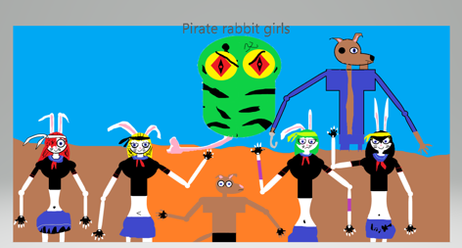HOME | DD
 Laboi — Moid Colony
Laboi — Moid Colony

#alien #biotic #colony #cucumber #echinoderm #effect #mass #men #modular #sophont #starfish #terrestrial #tomorrows #moid #sapient #all #alienspecies #masseffect #alltomorrows
Published: 2022-05-28 00:41:46 +0000 UTC; Views: 1886; Favourites: 9; Downloads: 0
Redirect to original
Description
From the planet Phun-Lewot, what looks like many species are simply variations of a singular species of terrestrial echinoderms. Every Moid is sapient and capable of both sexual and asexual reproduction, including across their many variations. When a moid produces asexually it produces more of its own variation, but when reproducing between another it can result in one of the several moid variations (even if their parents weren’t one of them). Despite radically different appearances all moids have several features in common, large lips, complex eyes, six limbs, six face tentacles, and at the end of their bodies they have four additional tentacles that evolved from former gills known as Gilimbs. Every once in a while, a new variation of moid is born which is a cause for celebration in their society. Another interesting feature of their biology is that when in physical contact with one another they are able to coordinate their functions between them, leading to moids civilization creating family-like colonies.
COMMAND MOID
Command Moids are the biggest and smartest of moid society and form the base of every moid colony. The newest variation in moid society, only having come into existence slightly over 300 years, their birth caused the entirety of moid society to blossom. Though cumbersome on their own, these moids have the ability to direct the function of many moids simultaneously and unlike regular moids they don’t need to be in direct contact. Thoughts, knowledge, feelings, and even sensory output can be shared between moids when they are in contact with a Command Moid.
GRAPPLER MOID
Grappler Moids are the most common of moids, there strong tails and nimble Gilimbs make them the most dexterous of the variations. Because of their usefulness almost every moid colony consists of a least two. Grapplers are mainly use in the acts of craftmanship and other functions that require precise work.
TRUNK MOID
Trunk Moids are the strongest of the moids able to lift several times their own wait. Their tails are mostly muscle and their Gilimbs evolved into harden claws that can sense vibrations in the ground. In the past they acted as trappers of moid society, baiting small areas, and stand perfectly still pretending to be plants before they crashed down on their prey. Now they use their great strength mainly to carry the entirety of a moid colony.
PEEPER MOID
Peeper moids are the smallest of moid society. Easy to carry they are used by moid colonies for their incredible eyesight. Their eyes are able to see in several spectrums including infrared and ultraviolet. Their Gilimbs are long and prehensile with hardened hooks at the end to allow them to scale ledges. Occasionally they will disjoin from the respective colonies to make use of their small size or act as spies.
LONG MOID
Long Moid are the protectors of the colony, alone they can also act as hunters. Their legs are vestigial instead using their long tails to slither. Their Gilimbs are flat and paddle-like and unlike the other variations retain their ability to absorb oxygen from water. They capture their prey with the sharp tentacles. They also have a sharp bard on their tongues capable of injecting a powerful neurotoxin.
FACE MOID
Face moids are usually second in command of a moid colony. Arboreal in nature face moids have opposable thumbs allowing them to grasp and climb. They are also the only moid capable of vocal communication, are able to translate the pheromone releases of the other moids.
SHIELD MOID
Shield Moids serve as the colony’s defense. The plates on their backs are as strong and light as Kevlar. Their facial tentacle has become hard and sharp, evolved in order for the Shield moid to dig, but also to fight. Shield Moid are usually deployed to protect the other moids in the colony.
























